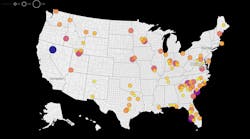Latest from Market Sales Estimates
Federal Reserve Bank’s Beige Book Sees Sluggish Conditions in Several Regions
As we head into the final weeks of 2020, many industry executives are recalibrating their 2021 business forecasts and are searching for any and all economic data that may offer additional insight into where the electrical market may be headed.
Electrical Marketing’s editors thought that Federal Reserve’s Beige Book report released earlier this week might provide an interesting macroeconomic perspective on the regional business climates in the Federal Reserve Bank’s 12 districts. The Beige Book is published eight times annually and was released on Dec. 2. Following is an excerpt from this report.
Most Federal Reserve Districts have characterized economic expansion as modest or moderate since the prior Beige Book period. However, four Districts described little or no growth, and five narratives noted that activity remained below pre-pandemic levels for at least some sectors. Moreover, Philadelphia and three of the four Midwestern Districts observed that activity began to slow in early November as COVID-19 cases surged.
Reports tended to indicate higher-than-average growth of manufacturing, distribution and logistics, homebuilding, and existing home sales, although not without disruptions. Banking contacts in numerous Districts reported some deterioration of loan portfolios, particularly for commercial lending into the retail and leisure and hospitality sectors. An increase in delinquencies in 2021 is more widely anticipated. Most districts reported that firms’ outlooks remained positive. However, optimism has waned — many contacts cited concerns over the recent pandemic wave, mandated restrictions (recent and prospective), and the looming expiration dates for unemployment benefits and for moratoriums on evictions and foreclosures.
Boston. Manufacturers reported increased revenues from a year ago, including some strong gains. Retailers and staffing firms continued recovering toward pre-pandemic levels, while the hospitality and tourism sectors remained hard-hit. Uncertainty about the course of the pandemic, vaccines and possible relief measures added caution to positive outlooks.
New York. The regional economy has been flat, and the labor market has remained weak. Manufacturing growth slowed, consumer spending and tourism were little changed, and a number of service industries saw declines in activity. Commercial real estate softened further, but most residential sales markets continued to show strength. Wages and other business input costs picked up modestly, while selling prices were little changed.
Philadelphia. Business activity held steady during the current Beige Book period and remained below levels attained prior to the onset of COVID-19. However, sharply rising COVID-19 cases triggered a downward trend in early November and heightened concerns over anticipated layoffs, foreclosures, evictions and bankruptcies. Meanwhile, modest job growth, slight wage growth and modest inflation continued.
Cleveland. Economic activity increased moderately, and staff levels increased slightly. Firms connected to IT, housing and consumer durables fared better than those connected to travel, energy and hospitality. Supply chain constraints boosted transportation costs and prices for certain construction and manufacturing inputs. Contacts expected a modest improvement in activity, but hiring plans were restrained because of the pandemic’s uncertain path.
Richmond. The regional economy grew moderately in recent weeks. Employment rose and demand for some professional business occupations was strong. Wage and price growth were modest. The housing market remained robust, and commercial real estate leasing improved somewhat. Port and trucking volumes reached robust levels and manufacturing activity picked up.
Atlanta. District economic activity modestly expanded. Labor markets continued to improve. Contacts noted some non-labor costs rose. Retail activity and auto sales were mixed. Activity in tourism and hospitality picked up slightly. Residential real estate demand was strong and home prices rose. Commercial real estate conditions remained challenged. Manufacturing activity increased. Conditions at financial institutions stabilized.
Chicago. Economic activity increased moderately but remained below its pre-pandemic level. Employment, consumer spending and manufacturing increased moderately. Business spending increased modestly while construction and real estate were flat. Wages rose slightly, as did prices. Financial conditions improved modestly. Strong harvests, government support and higher prices boosted expectations for farm income.
St. Louis. Reports from district contacts suggest economic activity has continued to increase slightly since the previous report. However, conditions deteriorated toward the end of the reporting period. The overall outlook for business conditions over the next 12 months has improved but remains slightly pessimistic.
Minneapolis. District economic activity grew moderately. Employment rose modestly, but obstacles such as child-care availability and virtual schooling for households with children impacted labor participation, particularly among women. Consumer spending grew slightly, with softening demand in some segments due to rising COVID-19 infections. Manufacturers generally saw brisk growth. Agricultural conditions improved slightly.
Kansas City. Economic activity continued to expand slightly. After rising in October, consumer spending fell slightly in November but was expected to bounce back in the coming months. Contacts in the manufacturing, residential real estate, wholesale trade, transportation and professional and high-tech services sectors all reported increased levels of activity. In addition, the energy sector held steady, and the agriculture sector improved moderately.
Dallas. Economic activity expanded modestly. Growth moderated in the manufacturing, retail and services sectors. The housing market continued to outperform expectations, but office leasing remained weak. Energy activity remained depressed though it showed further signs of improvement. Outlooks were positive, though highly uncertain due to looming concerns surrounding political uncertainty and the unknown course of the pandemic.
San Francisco. Economic activity in the district expanded modestly. Employment levels increased slightly, while price inflation showed little change. Sales of retail goods rose appreciably, but conditions in the services sector were unchanged. Manufacturing expanded moderately, and the agriculture sector improved slightly. Residential real estate activity continued to grow, while commercial markets changed little. Lending activity increased mildly.









